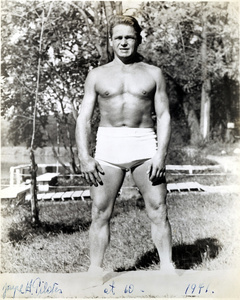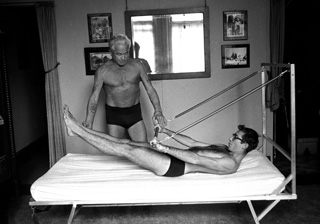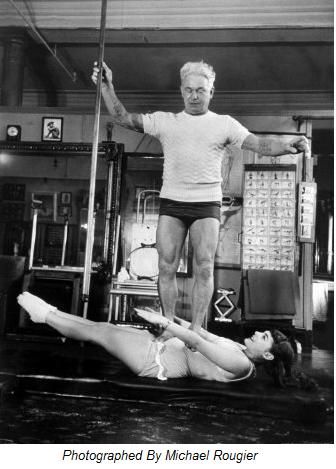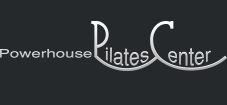The Method
At the origin, Joseph Pilates
Joseph Hubertus Pilateswas born on December 9th, 1883 in Mönchengladbach, Germany. His father (Friedrich) was a gymnast and his mother (Hahn) a naturopath, precursor of natural and alternative forms of therapy. He is a sickly child, suffering from rickets, asthma, and joint rheumatism. In order to regain his health, he started to study anatomy and to observe animals moving in situ….
«Take a horse for example. If someone wants him to make races, he should train him to be in the best shape possible. Why shall we not also keep humans in the best shape possible? » He said one day discussing fitness.
He quickly realized that mental and physical health is linked and he started studying very exotic disciplines at that time, such as yoga and various martial arts. He integrated these oriental methods to occidental fitness activities such as gymnastic or boxing, and he incorporated ancient Greek and Roman forms of exercising. He was convinced that a modern lifestyle (poor posture, incorrect breathing and ignoring postural muscles training…) is a determinant factor to weak health.
Already a young diver and a gymnast, Joseph moved to England in 1912. He practiced boxing professionally and was working as a self-defense teacher in police schools and Scotland Yard. In order to earn money, he participated to a circus show with his brother, where he played a Greek statue.

When Great Britain entered the First World War, Joseph was made prisoner as a foreigner enemy. Yet, it is in these difficult circumstances of internment, that he established the foundations of the Pilates method. He observed how animals stretch their bodies and he used his own observations in his training. He taught the movements he invented to his compatriots also in captivity, as a fitness coach / therapist would do. Thus, permitting immobilized prisoners (injured or disabled) to regain strength and life, by setting for example springs on their beds. He designed movements to prevent muscle loss and the result was so surprising that these prisoners became healthier than the able-bodied. With springs attached to the bed’s end, he developed the principle of resistance, which results in the design of the first machine used for the Pilates method practice, the Reformer. He also realized the benefit he could get from the use of machines on untrained persons, compared to mat workout. Thus, he dismantled a bunk bed, attached springs on the top frame and used this device for rehabilitation: the Cadillac machine was born.

Once released from prison, he returned to Germany and continued to train policemen in Hamburg. He also worked with dancers and experts in mind body practices such as Rudolf Laban. When the new German army tried to force him to become their coach, he left his country and emigrated to the United States. During the boat journey, he met his future wife, a nurse named Clara. They were married in New York and founded their own studio, where they started teaching the fitness method called at that time « Contrology ».
This revolutionary method was soon a great success, especially among dancers, acrobats, athletes and movie stars. His first clients were legendary dancers and choreographers such as Balanchine (co -founder of the New York City Ballet) and Martha Graham (creator of the Graham Dance Company). Rapidly, dancers from various companies in New York seized the Pilates method, which allowed them an accelerated rehabilitation from the various injuries inherent to their practice as well as building strength without losing flexibility.
Following that, Uncle Joe as called by his close friends, invented new movements and devoted his work to the design of new equipments, always based on the same principle: « intelligently designed movements, properly performed, with high precision and in balance, are much more efficient than hours of monotonous fitness training made of stereotyped exercises ».
Breathing, correct posture, harmonious development of postural muscles, movements performed without haste but with perfect precision and control are the characteristics of his method, as he explained in detail in his two books: « Your Health : A Corrective System of Exercising that Revolutionizes the Entire Field of Physical Education » published in 1934 and « Return to Life Through Contrology » published in 1945.

For over 40 years, Joseph Hubertus Pilates taught with his wife Clara in their studio known then as the « Pilates Studio » of 8th Avenue in New York. He died in 1967 at the age of 83, after dedicating all his life to others’ wellbeing and health. Clara joined him ten years later.
The Pilates Elders
The Pilates method started to be taught around the world by the « Pilates Elders », as were called the first students of Joseph Pilates. Their teaching varies with their own approaches, their personal experiences and their understanding of the method, which will produce different styles of the method.
Eve Gentry began to study with Joseph and Clara in 1938. She taught with them until 1968, and then opened her own dance school and Pilates institute in Santa Fe (New Mexico).
The acrobat Carola Trier, who escaped from a Nazi concentration camp in France, emigrated to the United States working there as a contortionist. In 1940, she approached Joseph Pilates when an injury prevented her from performing. In the late fifties, she opened her own « Contrology » studio in New York, with the consent of the creator of the method himself.
Ron Fletcher, un des danseurs de la Cie Martha Graham commence la pratique de la méthode Pilates dans les années quarante pour surmonter une blessure chronique du genou. En 1971, il ouvre un studio à Beverly Hills (Californie), qui devient vite très apprécié des stars du cinéma.
In 1941, Romana Kryzanowska a dancer with an injured ankle was advised by George Balanchine to make her rehabilitation with Joseph Pilates. She studied the method with him and when he passed away in 1967, she started to teach the method in the « Pilates Studio » with Clara Pilates. When Carla decided to retire, she appointed her as director of the studio.
Kathy Grant and Lolita San Miguel, both students of Joe and Clara became instructors in their turn. Kathy Grant was nominated at the head of the « Bendel’s Studio » in 1972, and Lolita San Miguel left teaching Pilates at the « Ballet Concierto » of Puerto Rico. Just before the death of Joe in 1967, both received a Pilates’ instructor certificate from the « State University of New York ». Among all the Ancients », Kathy and Lolita would be the only two students formally graduated by Joe himself.
Bruce King practiced for many years with Joseph and Clara Pilates. In 1970, he opened his own studio in New York.
Mary Bowen a Jungian analyst, who studied « Contrology » in the sixties, began teaching the Pilates method in 1975 and founded « Your Own Gym » in the Massachusetts.
Robert Fitzgerald also a student of the two founders opened his own studio in New York in the sixties. The studio was very popular among New York companies’ dancers.
